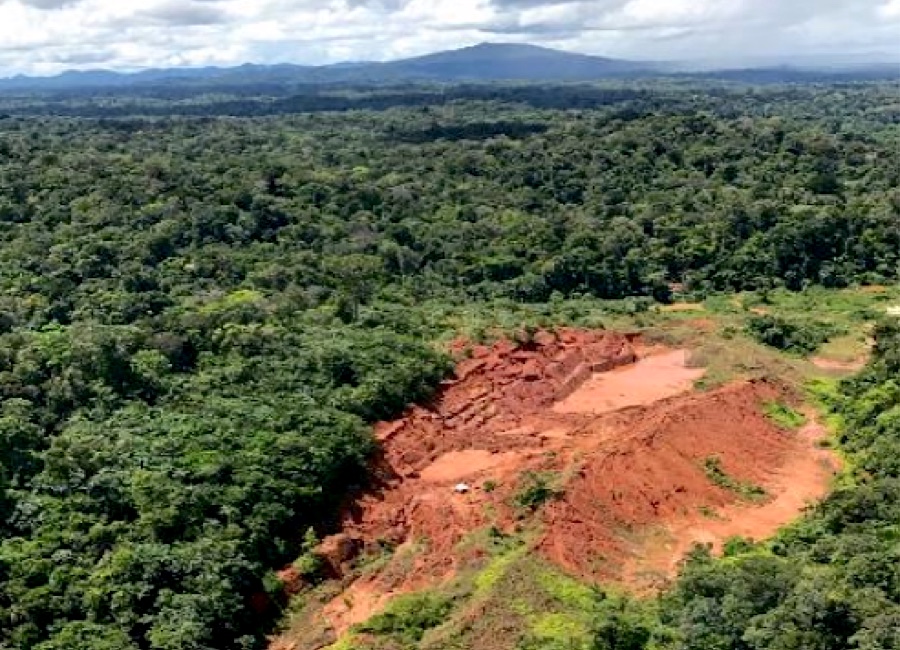
A drill program last year to validate historic resources at Reunion Gold ’s Nivre deposit in French Guiana has resulted in a 43-101 resource that is similar to its counterpart reported in 1998.
The Nivre deposit contains 18.9 million indicated tonnes grading 1.09 grams gold per tonne for 665,000 ounces of gold and 26 million inferred tonnes grading 1.06 grams gold for 883,000 ounces of gold.
The Dorlin mining district has been one of French Guiana’s major artisanal gold producing areas for more than a century
The mineralization is open at depth and along strike, and there remains significant potential to expand the resource, the company says.
The deposit is part of the company’s 84 square kilometer Dorlin gold project, about 180 km southwest of Cayenne.
Forty-two percent of the contained gold is hosted in laterite-colluvium and saprolite weathering domains.
The company has yet to drill zones between Nivre East/South and the West Zones pits.
The junior explorer plans to focus on expanding the resource with further drilling and testing eleven other targets that have been identified on the property. In the second quarter of this year, Reunion Gold will run additional IP surveys for a total of 60 kilometer-lines to test all remaining gold-in-soil anomalies, and will follow that work with 4,000 metres to test the targets during the remainder of 2019.
Reunion has an option to acquire 75% of the Dorlin project from Auplata Sa by completing a feasibility study and spending a minimum of US$3 million over three years. It can acquire an additional 5% stake for a consideration based on the project’s net present value estimated in the feasibility study.
The Dorlin mining district has been one of French Guiana’s major artisanal gold producing areas for more than a century. Alluvial gold was discovered along the Petit Inini River in 1901 and the area became famous for producing large gold nuggets.
Elsewhere in French Guiana Reunion Godld is advancing the Boulanger and Haute Mana projects. In Guyana it is exploring on the Waiamu, Aremu, Arawini and Oko gold projects.
Earlier this year Reunion Gold closed a strategic alliance agreement with Barrick Gold, which now owns 19.9% of the company.
Under the agreement, the two companies have formed a 50:50 alliance to jointly explore for, develop and mine certain mineral projects across the Guiana Shield, including French Guiana, Guyana, Suriname, and northern parts of Brazil.
Reunion has contributed its Waiamu, Aremu, Arawini and Oko projects in Guyana.
Under the arrangement, Barrick will initially fund an amount equal to $4.2 million on the projects as credit for Reunion’s historic exploration, with subsequent funding to be on a 50:50 basis between the two companies.
If Reunion acquires an interest or an option to acquire an interest in any other properties in the subject area, Barrick will have 90 days to decide whether to include the new project in the alliance.
If Barrick nominates a project under the alliance as a “designated” project, it then has the right to earn a 70% interest by solely funding the project and completing a feasibility study.
The alliance currently excludes Reunion’s Dorlin, Haute Mana and Boulanger projects in French Guiana, although Barrick retains a right of first refusal on these projects and can in the future define any project based on certain criteria as a designated project. If it does, then it must pay Reunion 50% of all costs the junior has incurred on the project to that date.
In mid-February. Reunion Gold raised $13.1 million in a private placement and will use the proceeds for exploration and development of its projects in French Guiana and Guyana.
Dundee Resources owns a 16.5% stake in the company.
Over the last year Reunion’s shares have traded within a range of$0.105 and $0.225 a share.
This article first appeared in The Northern Miner.
2 Comments
IPeterI Schissel
Go Reunion!
Jean Patrick Masumbuko
Congratulations